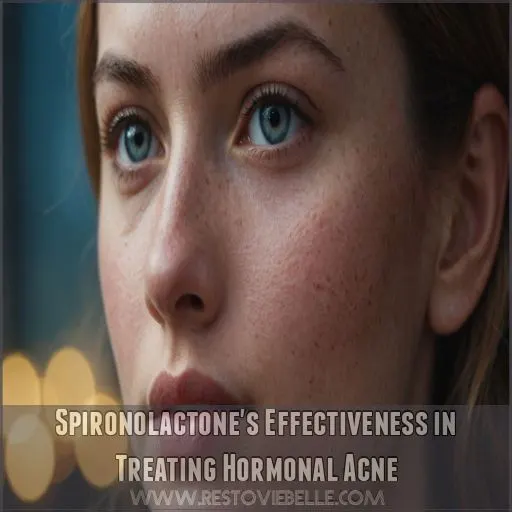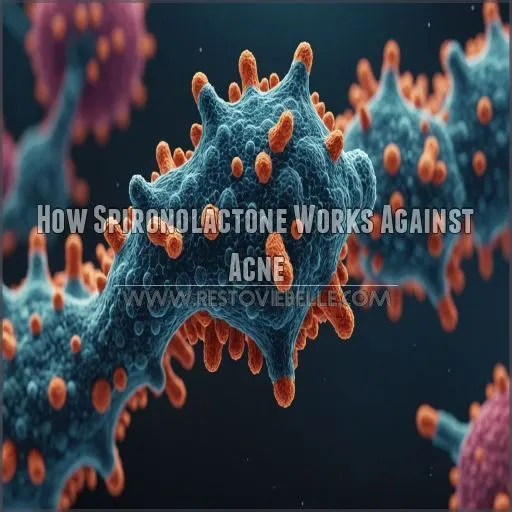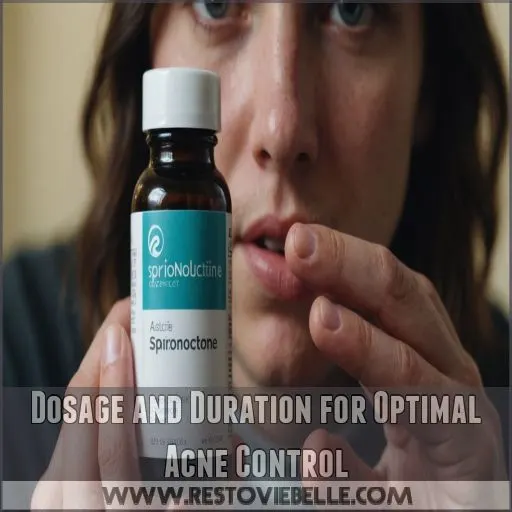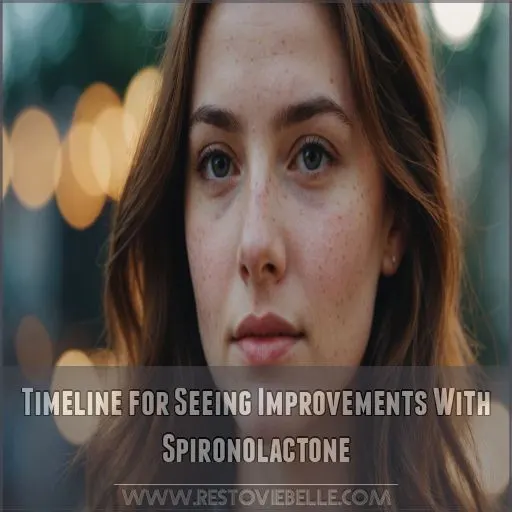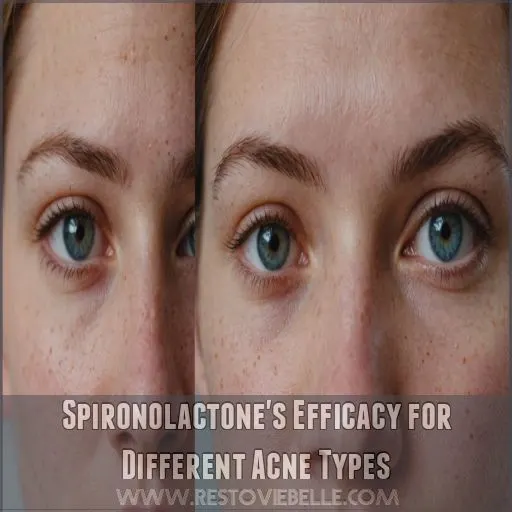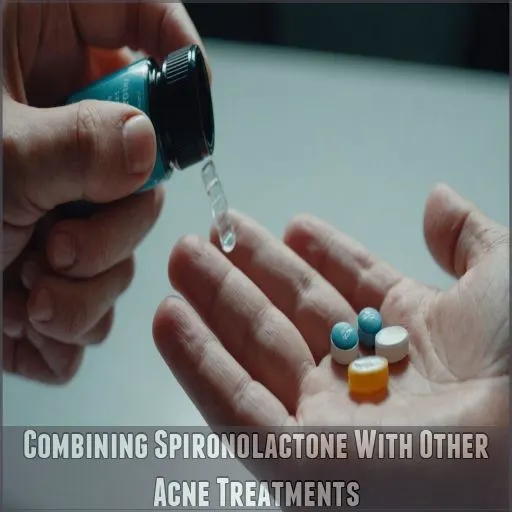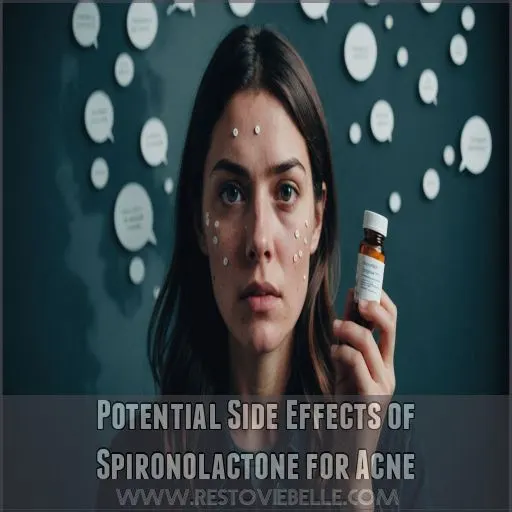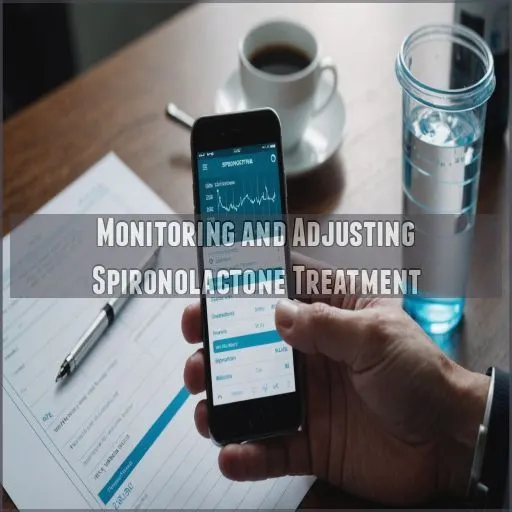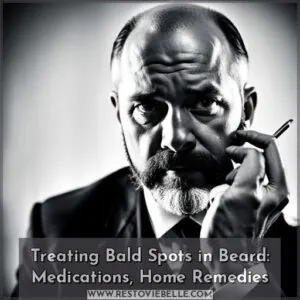This site is supported by our readers. We may earn a commission, at no cost to you, if you purchase through links.
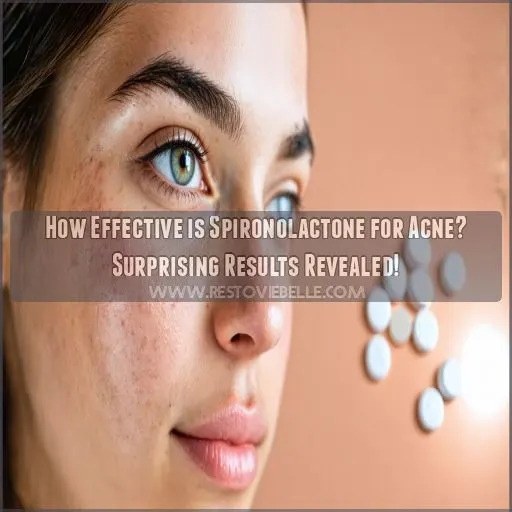
Unlike those topical creams that just scratch the surface, spironolactone tackles acne from the inside out. While it might not beat isotretinoin in a one-on-one, it’s safer for long-term use and easy as pie to get.
So, whether you’re fighting facial foes or body breakouts, spironolactone offers a promising solution. But, there’s more to know about its journey to clearer skin!
It’s also safer for long-term use.
Table Of Contents
- Key Takeaways
- Spironolactone’s Effectiveness in Treating Hormonal Acne
- How Spironolactone Works Against Acne
- Dosage and Duration for Optimal Acne Control
- Timeline for Seeing Improvements With Spironolactone
- Spironolactone’s Efficacy for Different Acne Types
- Combining Spironolactone With Other Acne Treatments
- Potential Side Effects of Spironolactone for Acne
- Who Should Consider Spironolactone for Acne
- Monitoring and Adjusting Spironolactone Treatment
- Real-world Experiences With Spironolactone for Acne
- Frequently Asked Questions (FAQs)
- How long does it take for spironolactone to work for acne?
- Is spironolactone better than Accutane?
- Why am I still breaking out on spironolactone?
- Does spironolactone clear back acne?
- Can spironolactone be used for teenage acne?
- What are spironolactones long-term effects on skin?
- Is spironolactone safe to use with birth control?
- How does spironolactone compare to isotretinoin?
- Can diet impact spironolactones effectiveness for acne?
- Conclusion
Key Takeaways
- You’ll find spironolactone impressive for hormonal acne, with up to 93% of women seeing major improvements, much like a skincare fairy godmother handling androgens and sebum production.
- Think of it as a trusty long-term companion; it’s safer for extended use compared to some heavy-hitters like isotretinoin, making it ideal for those looking to keep acne at bay over time.
- It’s not a one-size-fits-all solution, though. While it works wonders for hormonal and cystic acne, don’t expect the same magic on blackheads or whiteheads – you might need to mix and match treatments like an artist crafting a masterpiece.
- Be ready for some patience-testing, as results typically blossom over 3 to 6 months. But with consistent use – and maybe a bit of diet tweaking – you’ll likely see your skin’s mood brighten.
Spironolactone’s Effectiveness in Treating Hormonal Acne
You’ve likely heard of spironolactone as a treatment for hormonal acne.
You might be wondering just how well it works.
Recent studies have shown promising results, with up to 93% of women experiencing significant improvement in their acne symptoms after using this medication.
Success Rates in Clinical Studies
Spironolactone‘s success in treating hormonal acne has been turning heads in clinical studies. You’ll be thrilled to know that a significant majority of women saw dramatic improvements in their acne while using this medication (Source). Additionally, understanding the role of hormonal imbalances, diet, and stress in triggering acne is essential in managing the condition, as it can also be influenced by environmental factors and genetics.
By making dietary changes, such as avoiding dairy and sugar, and incorporating acne-fighting nutrients like zinc and omega-3s, individuals can further support their skin health effective natural acne treatments.
Here are three key findings:
1.
73.1% improvement on facial acne
2.
75.9% improvement on chest acne
3.
77.6% improvement on back acne
These impressive results suggest spironolactone is equally effective in treating acne across various body sites, giving you more control over your skin’s appearance.
Comparison With Other Acne Treatments
If you’re battling hormonal acne, you’ve got options.
It outperforms minocycline, matching the punch of birth control pills. Unlike topical treatments that barely scratch the surface, this oral medication tackles acne from within.
While isotretinoin might be the heavyweight champ, spironolactone’s safety profile makes it a smart choice for long-term use. Plus, you won’t need to jump through hoops with prescriptions or constant lab work.
Factors Influencing Treatment Outcomes
The effectiveness of spironolactone for acne hinges on several key factors.
Your treatment outcomes may vary based on:
- Patient compliance: Consistently taking the medication as prescribed
- Individual response: How your body reacts to the drug
- Concurrent medications: Interactions with other treatments
- Underlying conditions: Hormonal imbalances or other health issues
Healthcare providers closely monitor these factors, adjusting dosages and performing blood tests as needed. Remember, spironolactone isn’t a one-size-fits-all solution; your journey to clearer skin is unique and may require patience and fine-tuning.
Long-term Efficacy and Maintenance
Looking at long-term outcomes, you’ll be pleased to know that spironolactone often maintains its acne-fighting power over time.
Studies show it’s effective for years, with many women experiencing continued clear skin.
To prevent relapse, your doctor might recommend a maintenance dosage.
Remember, it’s not a quick fix – think of it as a marathon, not a sprint. Combining spironolactone with lifestyle factors and proper skin care can further boost its long-term efficacy.
How Spironolactone Works Against Acne
You’re about to discover how spironolactone tackles acne at its hormonal roots. This medication works by reducing androgen hormones and sebum production, effectively calming your skin’s inflammatory response.
Mechanism of Action on Androgen Hormones
Spironolactone’s effectiveness in treating hormonal acne stems from its unique mechanism of action on androgen hormones. This powerful medication works like a molecular bouncer, blocking androgens from binding to their receptors.
Here’s how it keeps your skin clear:
- Competes with testosterone for androgen receptor binding
- Decreases 5-alpha reductase activity
- Increases steroid hormone binding globulin levels
- Inhibits testosterone and DHT binding in skin
- Promotes an increased estrogenic state
By interfering with androgen activity at multiple levels, spironolactone helps regulate hormone imbalances that contribute to acne development (Source).
Effects on Sebum Production
For sebum control, spironolactone packs a powerful punch.
You’ll be pleased to know that this acne treatment can reduce sebum production by a whopping 30 to 50 percent at doses of 50 to 100mg daily.
By inhibiting sebaceous gland activity, spironolactone effectively tackles hormonal acne at its source.
This androgen reduction helps rein in those overactive oil glands, giving you the upper hand in your battle against breakouts related to regulating oil production
.
Impact on Skin Inflammation
The impact of spironolactone on skin inflammation is truly remarkable.
By reducing sebum production, it indirectly calms inflamed skin.
Studies show that spironolactone’s anti-inflammatory effects help decrease redness and swelling associated with acne. You’ll notice fewer inflammatory papules and pustules as treatment progresses.
This dual action on sebum and inflammation makes spironolactone a powerful ally in your fight against acne, offering a thorough approach to clearer skin that goes beyond just oil control.
Role in Regulating Hormonal Imbalances
How does spironolactone tackle those pesky hormonal imbalances causing your acne? By blocking androgen hormones, it’s like a bouncer for your skin, keeping excess sebum at bay.
You’ll likely see a reduction in breakouts within weeks, but give it 3 months for full effect.
Here’s what you might experience:
- A newfound confidence in your clear complexion
- Relief from the emotional rollercoaster of hormonal acne
- Freedom to go makeup-free without worry
- A sense of control over your skin’s health
- Hope for long-term acne management
Dosage and Duration for Optimal Acne Control
You’ll need to find the right spironolactone dosage and treatment duration to effectively combat your acne.
Understanding the best regimen can make the difference between clear skin and persistent breakouts.
So, let’s explore the key factors that determine your path to acne-free success.
Recommended Starting Doses
Now that we’ve explored how spironolactone tackles acne, let’s talk dosage.
Your doctor will likely start you off with 50 mg daily. This isn’t a one-size-fits-all situation, though. Some folks might need up to 200 mg per day for the best results.
Remember, good things come to those who wait – you’ll typically see improvements after 8 to 12 weeks. Stick with it, and you might just be amazed at the results!
Adjusting Dosage for Individual Needs
Finding your sweet spot with spironolactone dosage is like fine-tuning a radio – it takes patience and adjustment.
Your doctor might start you at 50 mg daily, monitoring your progress closely.
If you’re not seeing results after a few weeks, they may bump you up to 100 mg.
Remember, everyone’s skin is unique, so your personalized approach might involve tweaking the dose until you hit that acne-clearing harmony.
Treatment Duration for Visible Results
While you’re keen to see results, patience is key when using spironolactone for acne. Combining it with other acne treatments, like a synergistic blend of tea tree oil and salicylic acid, may enhance its effectiveness. Typically, you’ll start noticing improvements within 8 to 12 weeks. However, individual responses can vary, so don’t be discouraged if it takes a bit longer.
- Excitement builds as you anticipate clearer skin
- Frustration may arise if results aren’t immediate
- Relief washes over you when improvements begin
- Pride swells as your complexion transforms
Remember, consistency is vital. Stick with your treatment plan, and you’ll likely see significant changes in 3 to 6 months.
Maintenance Therapy Considerations
As you start your acne-fighting journey with spironolactone, it’s essential to understand the long-term commitment required for the best results. You’ll need to stick with it for optimal outcomes.
Let’s break down the maintenance therapy considerations:
| Duration | Dosage | Monitoring |
|---|---|---|
| 3-6 months | 50-100 mg daily | Baseline renal function |
| 6-12 months | Up to 200 mg daily | Potassium levels (45+ years) |
| 12+ months | Individualized | Regular dermatologist check-ups |
Remember, patience is key. Your skin’s transformation won’t happen overnight, but with consistent use and proper monitoring, you’re on the path to clearer days ahead.
Timeline for Seeing Improvements With Spironolactone
You’re excited to see results from your spironolactone treatment, but patience is key.
While some patients notice improvements within a few weeks, most experience significant acne reduction after 3 to 6 months of consistent use.
Initial Response Period
Once you’ve established the right dosage, you’ll be excited to see results.
The initial response period typically spans 6-8 weeks. During this timeframe, your body adjusts to the medication.
Don’t be discouraged if you don’t see immediate changes; it’s like planting a seed – growth takes time.
First results often emerge around the 3-month mark, with visible changes in oil production and acne reduction.
Progressive Improvement Stages
The journey to clearer skin with spironolactone is a marathon, not a sprint. You’ll likely experience initial breakouts as your skin adjusts.
Don’t lose heart! Gradual clearing typically begins around the 4-8 week mark.
As you progress, you may hit a plateau effect where improvement slows.
Stay the course – many women see significant results by the 3-6 month mark.
After that, you’ll enter the maintenance phase for long-term results.
Factors Affecting Treatment Speed
Several factors influence how quickly you’ll see results with spironolactone. Your individual response, dosage, skin type, and acne severity all play key roles.
Compliance is key – stick to your prescribed regimen for the best outcome.
Some folks might notice improvements in 8 weeks, while others may need 12 weeks or more. Remember, it’s not a race – your journey to clearer skin is unique, so be patient with the process.
Managing Expectations During Treatment
While factors like hormone levels influence treatment speed, it’s essential to set realistic goals for your spironolactone journey.
You’ll likely need patience, as full results often take 3 to 6 months to appear.
Don’t be discouraged if you don’t see immediate changes; improvement is gradual. Some patients notice clearer skin within weeks, while others may need longer.
Remember, everyone’s timeline is unique, so stay committed to your treatment plan.
Spironolactone’s Efficacy for Different Acne Types
You’ll be surprised to learn that spironolactone’s effectiveness varies across different acne types and body areas.
Research shows it’s particularly potent against hormonal and cystic acne on the face, chest, and back, offering hope for those struggling with persistent breakouts.
Effectiveness on Facial Acne
Spironolactone’s effectiveness on facial acne is impressive, with studies showing significant improvement in 73.1% of patients. You’ll likely notice a reduction in inflammatory lesions and sebum production, leading to clearer skin. Before-and-after comparisons often reveal dramatic transformations.
Identifying your acne type, such as hormonal acne, can help you understand how spironolactone works to address the underlying causes of your breakouts. Additionally, combining spironolactone with gentle, non-comedogenic cleansers can enhance its effectiveness.
Long-term use maintains results, with low relapse rates when proper dosage is maintained. Don’t be surprised if your stubborn hormonal acne finally meets its match – spironolactone might just be the game-changer you’ve been waiting for.
Results for Body Acne (chest, Back)
The battle against body acne isn’t limited to your face.
Good news: spironolactone packs a punch for chest and back acne too. Studies show impressive improvement rates of 75.9% for chest acne and 77.6% for back acne.
You’re not alone in this fight – many folks struggle with pesky body breakouts. With spironolactone, you’ve got a powerful ally to help clear your skin, giving you the confidence to rock that backless dress or go shirtless at the beach with impressive improvement rates.
Impact on Cystic and Hormonal Acne
Battling cystic and hormonal acne? Spironolactone might be your secret weapon.
Studies show it’s highly effective, with 85% of patients experiencing significant improvement. You’ll likely see a 73-78% reduction in acne on your face, chest, and back.
This anti-androgen medication tackles hormonal acne triggers at their root, often clearing stubborn cysts that other treatments can’t touch.
Remember, patience is key – it can take 3-6 months to see full results.
Limitations for Certain Acne Forms
While spironolactone shines against hormonal and cystic acne, it’s not a one-size-fits-all solution.
You’ll find it less effective for comedonal acne, those pesky blackheads and whiteheads. Nodular acne may also prove resistant.
For inflammatory acne causing scarring, spironolactone can help, but you might need additional treatments.
Remember, your acne’s unique, so work with your dermatologist to tailor a treatment plan that addresses your specific concerns and skin type.
Combining Spironolactone With Other Acne Treatments
You’re not limited to using spironolactone alone in your acne-fighting arsenal. Combining it with other treatments can enhance its effectiveness, allowing you to tailor your approach for the best results.
Synergistic Effects With Topical Treatments
Considering acne types, when you blend spironolactone with topical treatments, you’re onto something big.
This combined therapy can optimize your acne regimen by maximizing results.
Including topical agents like benzoyl peroxide or retinoids, known for their synergy, enhances spironolactone’s effectiveness.
So, incorporating both oral and topical strategies provides a holistic approach, helping achieve clearer skin and fulfilling treatment goals.
Integration With Oral Contraceptives
Teaming up spironolactone with oral contraceptives can offer a powerful acne-fighting duo, combining hormonal regulation with sebum control.
Here’s what to keep in mind:
- Contraceptive Choice: Select types approved for acne, like Ortho-Tri-Cyclen and Estrostep FE.
- Efficacy Comparison: Expect benefits in reducing menstrual irregularities.
- Side Effect Risks: Be mindful of potential issues like breast tenderness and fatigue.
Compatibility With Other Systemic Medications
Spironolactone pairs well with other systemic acne treatments, providing options beyond oral contraceptives.
You’re in control when combining it with antibiotics or hormonal therapies.
Potential drug interactions require careful oversight, but integrating spironolactone allows for a personalized approach, adapting to your body’s needs and preferences.
This flexibility in systemic treatment alternatives lets you manage acne while minimizing negative side effects, allowing for a tailored treatment plan that suits your needs, which is a key factor in minimizing negative side effects.
Customizing Combination Therapies for Best Results
To truly maximize spironolactone’s acne-fighting potential, consider combining it with other treatments, such as incorporating natural remedies like epsom salt for acne that reduce inflammation and eliminate germs effectively. Effective combinations might also include using Epsom salt baths to absorb magnesium through the skin and exfoliate dead cells.
Effective combinations might include:
- Topical antibiotics like clindamycin for targeted bacteria control.
- Oral contraceptives to stabilize hormones and complement spironolactone.
- Topical retinoids for enhanced skin renewal.
- Benzoyl peroxide to prevent resistance and achieve broader results.
These regimens should be adjusted to individual needs for the best outcomes.
Potential Side Effects of Spironolactone for Acne
When you’re considering spironolactone for acne, it’s essential to understand the potential side effects that may come with this treatment.
While many experience only mild issues like increased urination and menstrual changes, rare but serious reactions such as elevated potassium levels can occur, necessitating regular monitoring.
Common Mild Side Effects
As you start taking spironolactone for your acne, you might experience some mild side effects like increased urination, menstrual changes, breast tenderness, bloating, or headaches.
Don’t worry – these are common and usually manageable. Just keep an eye out and let your doctor know if anything becomes bothersome.
| Side Effect | Percentage of Patients Affected |
|---|---|
| Breakthrough Bleeding/Spotting | 22.7% |
| Amenorrhea (Cessation of Menses) | 6.4% |
| Lightheadedness/Dizziness | 6.4% |
| Breast Tenderness | 3.6% |
| Increased Urinary Frequency | 3.6% |
Rare but Serious Adverse Reactions
While considering Spironolactone for acne, you should know about some rare but serious adverse reactions.
These include potential risks like:
- Hyperkalemia, which can affect heart and kidney function.
- Concerns about an increased risk of breast cancer, though not strongly evidenced.
- Possible interactions with other medications, which might complicate treatment.
Always discuss these risks with your healthcare provider.
Managing and Mitigating Side Effects
Managing spironolactone’s side effects can be a breeze with a few savvy strategies.
Monitor your potassium levels, tweak your diet accordingly, and stay well-hydrated.
Pay attention to when you take the medication and manage symptoms proactively. For instance, consider adjusting the timing to minimize dizziness or nausea.
These steps help maintain control, ensuring acne treatment doesn’t sideline you.
Long-term Safety Considerations
Understanding spironolactone’s long-term effects for acne involves recognizing potential side effects, like irregular menstruation, dizziness, and headaches.
Men face additional risks, such as gynecomastia, leading to treatment discontinuation.
Close monitoring and awareness of these effects, along with any contraindications, help create a balanced approach to using spironolactone for large pores confidently, offering effective treatment while minimizing risks when using products like pore minimizing treatments
.
Who Should Consider Spironolactone for Acne
If you’re a woman struggling with hormonal acne, spironolactone might be worth considering, especially if other treatments haven’t worked.
It’s important to evaluate your hormonal factors and talk to a healthcare professional to make sure it’s the right fit for you.
Ideal Candidates for Treatment
After considering potential side effects, it’s time to determine who should consider spironolactone for acne.
Women with hormonal acne, particularly those with a family history of the condition and who’ve faced prior treatment failures, might benefit greatly.
Considering your age and potential medication interactions are also very important when evaluating spironolactone as an option.
Contraindications and Precautions
Considering spironolactone for acne involves reviewing contraindications and precautions.
Avoid it during pregnancy due to potential risks. Those with breast cancer concerns should consult their doctor.
While kidney function issues require careful potassium monitoring. Watch out for medication interactions, as they can alter effectiveness.
Always discuss these factors with your healthcare provider before starting spironolactone.
Age and Gender Considerations
As a woman, you may be an ideal candidate for spironolactone to treat your acne.
This medication is primarily prescribed for women, as it targets hormonal imbalances that can cause breakouts.
However, men with adult-onset acne may also benefit, though the evidence is more limited. (Source)
Discuss your age, gender, and medical history with your dermatologist to determine if spironolactone is right for you.
Evaluating Hormonal Factors in Acne
Hormonal acne, often triggered by elevated androgen levels, might benefit from spironolactone, especially if lifestyle changes or birth control options haven’t sufficed.
If stress worsens your acne, impacting androgen levels, this medication could be a game-changer.
However, it’s typically recommended for women, as it addresses the hormonal factors effectively. Consulting with your dermatologist will help tailor the best approach.
Monitoring and Adjusting Spironolactone Treatment
When taking spironolactone for acne, it’s essential to have regular check-ups.
These check-ups allow your doctor to assess your progress and make necessary adjustments.
Monitoring your blood potassium levels is also vital, as it helps adapt the treatment to your individual response, guaranteeing both effectiveness and safety.
Regular Check-ups and Assessments
Scheduling regular check-ups while on spironolactone is very important for effective acne management.
During these visits, doctors review your progress, assess treatment adjustments, and monitor potential medication interactions.
It’s not just about tracking enhancement but also ensuring long-term effects are minimal.
By maintaining these assessments, you hold the reins, ensuring your path to clearer skin is both safe and effective.
Blood Tests for Potassium Levels
When you’re on spironolactone for acne, it’s essential to regularly check your potassium levels. Keeping tabs on this ensures your safety, as both high and low potassium levels can cause issues.
Testing frequency varies, but your doctor will guide you.
Hormonal fluctuations, such as those experienced during menopause symptoms, can affect treatment. Additionally, stress associated with menopause may impact acne severity.
Remember, interpreting results correctly is key to adjusting treatment safely.
- Makes sure safety by monitoring potassium
- Frequency depends on individual needs
- Interpret results with medical guidance
Adapting Treatment to Individual Responses
You’ve completed blood tests, now let’s focus on tailoring spironolactone treatment to individual needs. Adjust dosage based on your body’s response and monitor progress regularly. Personalized regimens help get the best results over treatment duration.
| Factor | Strategy |
|---|---|
| Dosage adjustments | Gradually increase if tolerated |
| Monitoring progress | Schedule regular check-ups |
| Treatment duration | Assess every few months |
This approach maximizes effectiveness and minimizes side effects.
When to Consider Alternative Treatments
Struggling with treatment resistance or unpleasant side effects from spironolactone? Evaluate alternative treatments.
Pregnancy plans, cost, or limited insurance coverage also warrant reassessment.
Regular check-ups can reveal when spironolactone’s benefits are waning, prompting shifts to other therapies.
Your dermatologist can guide adjustments for safer, effective acne management, ensuring your health and satisfaction come first in addressing these challenges.
Real-world Experiences With Spironolactone for Acne
You may be surprised to learn that spironolactone can be highly effective for treating acne in the real world.
In fact, studies show that the majority of women who use spironolactone for their acne experience significant improvements.
With many achieving complete clearance.
Patient Satisfaction Rates
Let’s take a look at spironolactone’s patient satisfaction rates, revealing promising real-world experiences.
While patients report overall improvement, results vary with side effects impacting satisfaction.
Consider these insights:
- Consistency Matters: Regular use sees better results.
- Patience Pays Off: Improvements often span weeks.
- Side Effects: They may affect your experience.
- Success Stories Abound: Many find meaningful acne relief, illustrating spironolactone’s potential.
Before and After Treatment Comparisons
Patient testimonials and photo comparisons reflect spironolactone’s impact on acne. Before and after treatment, acne severity scores show noticeable improvement. Individual results vary, with differences in treatment duration.
Here’s a snapshot:
| Aspect | Before Treatment | After Treatment |
|---|---|---|
| Acne Severity | High | Low |
| Treatment Duration (weeks) | 12 | 24 |
| Individual Satisfaction | Moderate | High |
Real-world experiences underscore its effectiveness.
Managing Treatment Expectations
After seeing before and after results, understand that managing expectations with spironolactone is super important.
Here’s a checklist to guide your journey:
- Initial Response Time: Often slow, so patience is key.
- Treatment Duration: Consistency over several months boosts effectiveness.
- Individual Variation: Realize responses differ widely.
- Relapse Risk: Mitigate by focusing on long-term goals.
Stay informed and adaptable.
Long-term Success Stories and Challenges
Many find spironolactone effective for long-term acne management, though challenges remain.
Relapse rates can fluctuate, and maintenance therapy is often essential to sustain benefits.
Patient perspectives highlight diverse experiences—some struggle with side effects over time, such as menstrual irregularities, while others enjoy clear skin without significant issues.
Ultimately, long-term results depend on individualized treatment plans and monitoring.
Frequently Asked Questions (FAQs)
How long does it take for spironolactone to work for acne?
You may start seeing a decrease in breakouts and oiliness within a few weeks, but it can take up to 3 months to see the initial response.
It can take up to 5 months for the full effect of spironolactone for acne.
Is spironolactone better than Accutane?
Choosing between spironolactone and Accutane largely depends on your acne’s specific cause.
Spironolactone is great for hormonal acne due to its hormone-blocking effects, whereas Accutane often provides a more aggressive, permanent solution for severe acne.
Why am I still breaking out on spironolactone?
Don’t worry if you’re still breaking out; spironolactone can take 3 to 6 months to show full effects.
Initial flare-ups are possible as your body adjusts.
Consider complementing with other acne treatments for better results .
Does spironolactone clear back acne?
Spironolactone effectively clears back acne by reducing androgen levels, which decreases oil production and helps with controlling sebum levels regulating sebum production
.
Studies show a 6% improvement in back acne, making it a reliable option for many who struggle with acne in this area.
Can spironolactone be used for teenage acne?
You can use spironolactone for teenage acne, especially in adolescent females.
It’s shown safety and effectiveness, with significant improvement in acne observed over several months, making it a viable option for persistent cases.
What are spironolactones long-term effects on skin?
Over time, spironolactone’s effects on the skin include acne reduction, but it may cause side effects like irregular menstruation, dizziness, and breast tenderness in some users.
Concerns about estrogen-sensitive cancers remain unproven in humans.
Is spironolactone safe to use with birth control?
Combining spironolactone with birth control is generally safe.
Effectively treating conditions like acne and PCOS by managing hormone levels is a key benefit of this combination.
However, always disclose all medications and health conditions to your doctor for personalized guidance.
How does spironolactone compare to isotretinoin?
While spironolactone may be an effective alternative to oral antibiotics.
Isotretinoin remains the gold standard for treating most forms of acne.
However, the choice depends on individual comfort with risks and benefits of each medication.
Can diet impact spironolactones effectiveness for acne?
To maximize spironolactone’s effectiveness for acne, you should monitor your potassium intake, as high potassium levels can cause issues. Avoid potassium-rich foods like bananas and supplements to prevent negative interactions.
Conclusion
Picture a smooth journey with spironolactone as your skincare companion.
If you’re wondering how effective spironolactone is for acne, it’s like a reliable friend who knows exactly how to tame hormonal chaos. Many women see significant improvements, showing its strong potential.
While it may take time to see major changes, combining it wisely with other treatments can boost results. Remember, it’s essential to manage expectations, stay patient, and keep in tune with your skin’s needs.
You’re on your way to clearer skin, with spironolactone as a trusted companion that can help bring about significant improvements.

